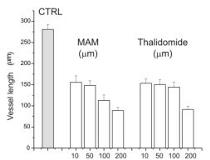IMPAIRED VASCULOGENESIS AS A MECHANISM OF CENTRAL NERVOUS SYSTEM MALFORMATIONS
Abstract number :
IW.09
Submission category :
Year :
2005
Submission ID :
5036
Source :
www.aesnet.org
Presentation date :
12/3/2005 12:00:00 AM
Published date :
Dec 2, 2005, 06:00 AM
Authors :
Kerri Hallene, Emily Oby, Nicola Marchi, and Damir Janigro
Malformations of cortical development (MCD) result from abnormal neuronal positioning during corticogenesis. Animal models of neurological disorders have been a crucial step toward the understanding of the mechanisms involved and discovery of therapeutic factors. In the case of MCD, several models are available but the one that most realistically recapitulates the morphology of human focal cortical dysplasia is based on pre-natal exposure to methylazoxymethanol acetate (MAM). Since MAM rats also exhibit changes in brain vasculature we tested the hypothesis that MAM causes vascular dysplasia leading to neuronal migration disorders. We compared the results obtained with MAM to those seen after pre-natal exposure to the known angiogenesis inhibitor thalidomide (THAL). Bovine aortic or rat brain endothelial cells used for Matrigel in vitro angiogenesis assays. Matrigel plugs were used for in vivo evaluations. MAM (15mg/kg) or THAL were injected on day E15. Standard electrophysiological techniques were used to record epileptiform activity in vitro. MAM caused a dose-dependent inhibition of angiogenesis in vitro (K50 around 0.2 mM, which is less than that typically used to cause neuronal cell death; see Fig. 1) and in vivo. These effects were reproduced by the known angiogenesis/vasculogenesis inhibitor thalidomide (THAL, also in Fig. 1). Both MAM and THAL newborn were characterized by microcephaly. Pre-natal THAL lead to development of white matter heterotopias and hippocampal dysplasia similar to what is observed with MAM and previously attributed to a selective neuronal (precursor) death mechanism. Cortical areas characterized by abnormal vasculature and neuroarchitecture were associated with regions of altered neuronal firing, suggestive of altered inhibition. MAM and THAL animals both exhibited abnormal distribution and increased size/density of penetrating pial vessels and capillary networks. Our results suggest that pre-natal exposure to MAM and THAL may cause MCD by interfering with both vascular development and neuronal differentiation/migration. The exact mechanisms involved (VEGF or bFGF?) remain unknown.[figure1] (Supported by HL51614, NS43284, NS38195 and NS46513 to DJ.)
